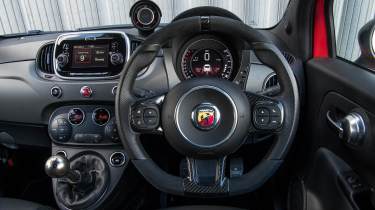Abarth 595 – interior and tech
The high driving position feels odd and there are some quality quirks, but higher-spec models in particular feel quite special
Constant updates throughout their lives meant the 595 and 695 generally kept pace with rivals in terms of infotainment, but they do have some more fundamental issues that may immediately deter some buyers.
The driving position is quite odd for a start. We’ve got used to small cars having raised seating positions and tall cabins but you really do feel quite perched in the Abarth, sat behind a steering wheel that’s canted away from you slightly like an old Mini (albeit not to the same extent, thankfully) and pedals that you almost press down rather than forwards. For taller drivers and front passengers you may find your knees rubbing against the centre console from which the gearshift sprouts, while room in the rear is tight.
There are positives, however. Visibility is generally excellent, as even the C-pillars are slim. That dash-mounted gearshift might remind you of an MPV from the ’90s, but it’s more favourably compared with the EP3 Civic Type R, and sports a slick change.
And like the exterior, there are fun touches wherever you look. Even the basic 595 gets nifty sports seats. Move up to the Turismo and you get leather trim and a tactile aluminium gearknob with proper alloy pedals, while the Competizione gets slim-backed Sabelt buckets, Alcantara and splashes of carbonfibre wherever you look. Seek out minor switches or doorcard plastics and things can look cheap, but the important bits you regularly interact with are of real quality.
Modern features like CarPlay, Android Auto, navigation and Beats audio are available, but they’re let down slightly by the relatively small seven-inch screen (and the standard display is just five inches), which also badly reflects light on brighter days rendering the screen nearly invisible. Worth noting too that the Abarth’s standard headlights are lousy, and the last model we tested had wipers that would noisily drag across the screen like they would on a 30-year-old Uno. It’s these details that make this car feel old-fashioned.




